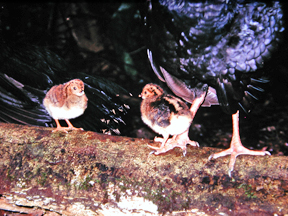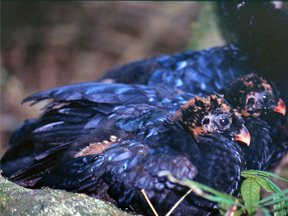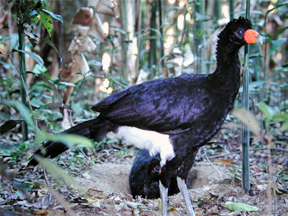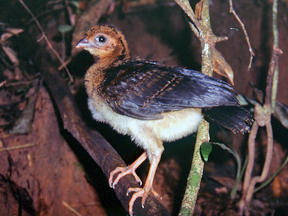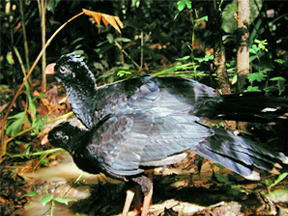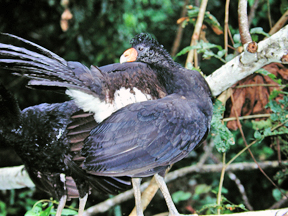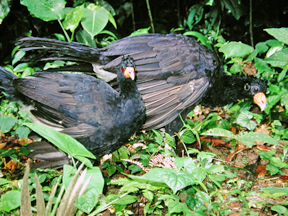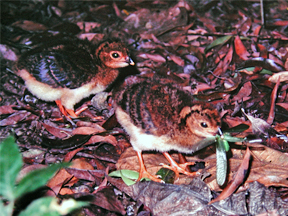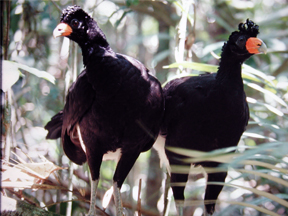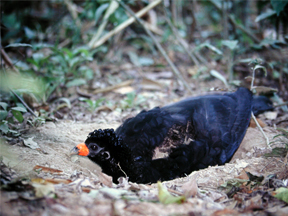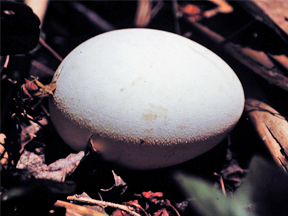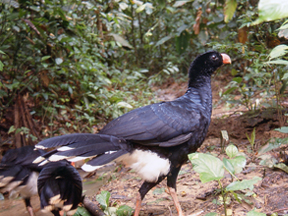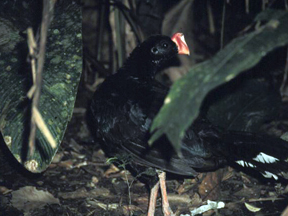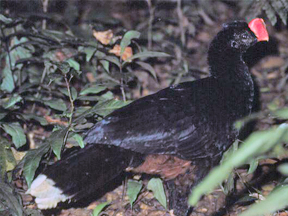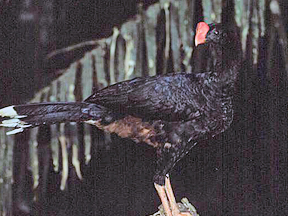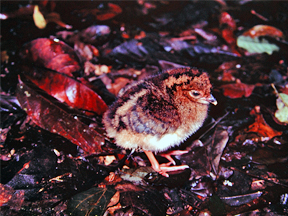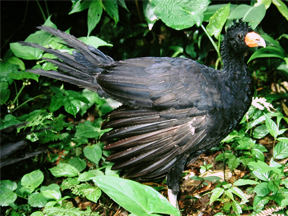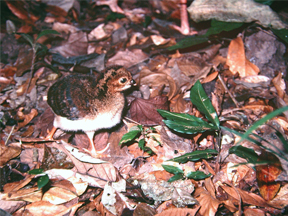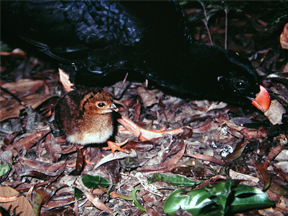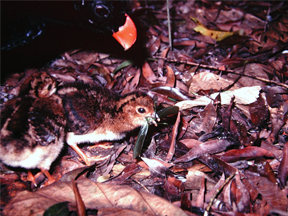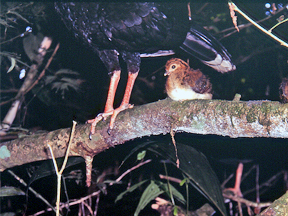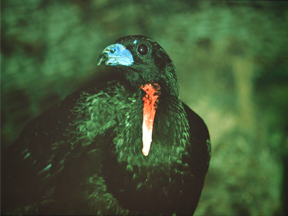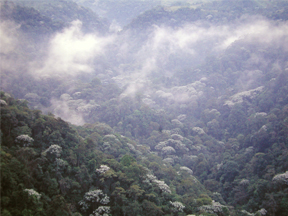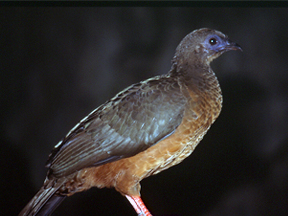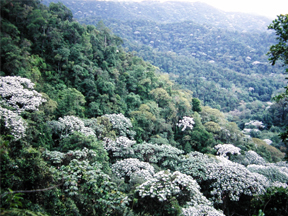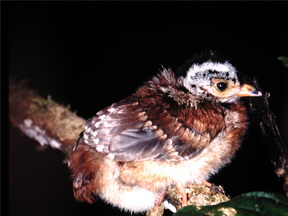Previous Research
- Curassows
- Andean guans
Curassows
Curassows (Family: Cracidae) are among the most threatened neotropical birds due to hunting pressure and logging. They are large birds (2-4 kg), which spend most of their time in the forest floor and only go in the trees to roost, to escape terrestrial predators, or occasionally to eat fruits or leaves. Their diet is composed mainly of fruits (70%, more than 100 species), but they also eat invertebrates, cotyledons, seeds, flowers, leaves, and small vertebrates. Curassows eat mainly fallen fruits under tree canopies, but they also eat from understory plants like Psychotria spp. and Heliconia spp. Curassows can visit the same tree to eat fruit, seed and cotyledons, suggesting that they may have a great impact on the dispersal, establishment, and recruitment of the species they feed on.
In 1998, I worked as an assistant for a study entitled “Complementary or substitutable foods: what do curassows forage for?” in the Centro de Investigaciones Ecológicas la Macarena (CIEM), , Colombia, conducted by Dr. Ivan Jiménez. We used a group of Salvin’s Currassows as a model organism. We manipulated the fruit abundance on the feeding patches and measured the quantity of different diet items that the currasows consumed. It seems that the curassows complement their fruit diet with leaves These birds likely obtained nitrogen from leaves and energy from fruits based on nutritional analyses of these items, see Jiménez et al. 2001 for details.
In January – July 1999, together with Juan L. Parra, Yaili Molina and Marta S. Agudelo, I collected data for our undergraduate thesis, with special collaboration by Rosario Castañeda. We studied a pair of Salvin’s (Mitu salvini)and Black (Crax alector) Curassows in the Centro de Investigaciones Ecológicas la Macarena (CIEM), Colombia. Our principal questions were: 1) do the curassows use different forest types following the fruiting phenology?; 2) how does the diet vary between individuals and species and throughout time?; and 3) do the currasows know where their food resources are? To answer these questions we followed two pairs of currasows from 5:30-18:30 every day during our study.
We analyzed their use of space by drawing their daily trajectory using all the known places (e.g., trails, nests, fruiting trees, creeks) that the curassows passed by during the observation period. These daily trajectories were plotted on a trail map of the study area. To measure fruit availability, we placed plots (50 x 5) and fruits traps (1m2) within these plots in the different forest types. We collected the fruits from the trap weekly and counted the fruits on the small bushes inside the plot. To quantify their diets we counted the number of items within each food category (during one minute every four minutes) eaten by each individual (male and female). To determine whether the curassows “know where to go” when they are searching for fruits, we set up a rope two times per week per species for twelve hours of observation (one full day in the field). Flagging tape was placed on the rope every ten minutes as we followed the pair and also during different behaviors such as feeding, resting, sunbathing, and encounters with other animals. The next day, after the rope was released, we used a 5m rope to measure the trajectory and a compass to measure the direction. The majority of this work is in our undergraduate theses, and a small portion is published (see Parra et al. 2001).
In 2000 I collaborated with Ivan Jiménez in conducting a survey of the Great curassow (Crax rubra) in La Selva Biological Station in Costa Rica. We conducted surveys at different times of the day and recorded aural and visual detections. Our objective was to find a way to more accurately estimate densities for members of this family. This information is published (see Jiménez et al. 2003).
In 2001 Juan L. Parra and I collaborated with Ivan Jiménez in the data collation for his PhD dissertation. We worked with the Razor-billed curassow (Mitu tuberosa), examining the information free-ranging foragers use to make the decisions to leave food patches.
Andean Guans
Andean birds are poorly studied compared to birds of lowland forest. Andean forest has fewer species and higher number of endemic birds. The species in the cracid family are no exception, they are poorly studied and many are restricted-range endemics. During 2002 and 2004, I worked for the Wildlife Conservation Society (WCS) Colombia program, where I collaborated with Marcia Muñoz, Margarita Ríos and Gustavo Kattan in the development of a one year survey of three species of guans (Cauca Guan (Penelope perspicax), Sickle-winged Guan (Chamaepetes goudotii) and Wattled Guan (Aburria aburri)) in the Central Andes of Colombia in the Santuario de Fauna y Flora Otun Quimbaya, Risaralda.
The Cauca Guan is endemic to the Central and Western Colombian Andes, The Wattled Guan occurs from Venezuela to Peru, but is rare throughout its geographic distribution. The Sickle-winged Guan is distributed from Colombia to Bolivia and is fairly common along its distribution. We also collected distribution data on other large frugivorous species: Red-ruffed Fruitcrow (Pyroderus scutatus), Golden-headed Quetzal (Pharomachrus auriceps), Crested Quetzal (Pharomachrus antisianus), Collared Trogon (Trogon collaris), Emerald Toucanet (Aulacorhynchus prasinus), Crimson-rumped Toucanet (Aulacorhynchus haematopygus), Andean Coock-of-the-Rock (Rupicola peruviana), and the Green Jay (Cyanocorax yncas).
Surveys were conducted monthly during one year along six one-kilometer trails. Eight surveys were conducted per trail per month, four in the morning and four in the afternoon, for a total of 48 surveys per months Ad libitum observations were conducted during these months on behavior, diet, movements and general natural history. Most of these data are in the publication process and some are already in press (see Rios et al. 2005).

